When given the opportunity, I always like to recommend hiring a private tour guide when traveling. Whether you cruise to distant lands, hoof it on your own using the trains, or grab a car and take in the sites at sixty miles per hour, a private guide is always worth it and frankly, not that much more expensive than the cost of those cruise excursions. Everyone has a different interest but trust me, there is a guide available for each and every one of us and our particular passion. Sandy and I travel for history so naturally, we focus on finding guides who are experts in tours which focus on the historical subjects we want to dig into. Some folks are foodies and depending on the city you’re in, there are guides who can accommodate your tastes (pun intended). If you’re into fashion or shopping, I guarantee there are guides in Paris who specialize in those areas. The good guides will take you to offbeat places and get you into buildings and rooms no one is allowed in (I’ve mentioned in previous blogs about some of our exploits with Raphaëlle in Versailles and Paris).
So, today I’d like to tell you the story of Jacques and the day we spent with him in Normandy France many years ago.
Did You Know?
Did you know that clocks and watches use the Roman numeral IIII rather than IV? It’s a classic design but look at the four on your watch dial (assuming it uses the Roman design). We were all taught to use “IV” to denote the Roman numeral four (if you weren’t paying attention in school, I’m confident you at least learned this by watching the annual NFL Superbowl games). I know this question has been keeping you up at night even in the modern era of “Googling.” Contrary to popular opinion, it’s not because of the decline and fall of the Roman Empire. The original Roman way to represent four was using IIII while the number nine was represented by VIIII. The “modern” version of four began to be used in Rome as part of the sundials and yes, even pocket sundials. By the thirteenth century, technology had advanced with mechanical clocks displacing sundials. Medieval clock makers decided to retain the Roman numerals but since the majority of people had no education, including rudimentary arithmetic, they decided to use IIII. The symbol IV required basic math skills – namely, subtraction – and that was considered too complex. So, we may ask, why was IX used since it presented the same obstacle? Actually, there are several theories to explain why IIII is used but I see my time is running out and I only have IIII more minutes to finish this blog. By the way, Big Ben uses IV ⏤ the English have always had a dry sense of humor.
Our Trip to Paris
Sandy had business in Hamburg, Germany and she suggested I fly from Nashville (we had just moved there from Southern California) and meet her in Paris at the tail end of her trip. Starting to sound like the beginning to a Tom Hanks and Meg Ryan movie? So, I flew over in early September and we stayed in a wonderful small hotel on Rue Cambon next to Coco Chanel’s original retail store and her apartment (refer to blog Coco Chanel: Nazi Collaborator or Spy? [click here to read]). We were there a week and I planned a day trip to the Normandy beaches since Sandy had never been there. My last visit to Normandy and Paris was thirty-four years earlier in the summer of 1973 when I backpacked through Europe with a high school friend.
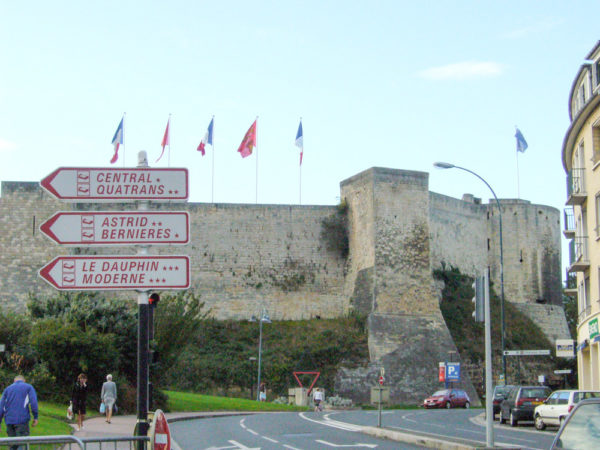
One of the decisions I made was to hire a private guide to take us around Normandy and highlight the D-Day sites we could realistically see in one day. I actually found Jacques through American Express Travel. Sandy and I took the afternoon train from Paris to Caen and stayed at the Hotel Ibis Caen Centre. We were in the middle of the city and it was quite convenient for walking to the castle. The next morning, our guide was to pick us up in front of the hotel.
We Meet Jacques Perreau
Precisely at nine, Jacques drove up, we got in, and off we went. Our first stop was Bayeux to see the Bayeux Tapestry. (See the full Bayeux Tapestry here and learn the story it tells.) I figured we were there so we might as well see it. Sandy had never seen the tapestry, but I saw it in 1973 when it was exhibited in a dank, musty old warehouse. This time, the tapestry was housed in a modern building and behind glass with systems to control climate and light. Jacques got us in an hour before it opened to the general public ⏤ that’s when I knew we had the right guy. Then we were off to our first D-Day site.
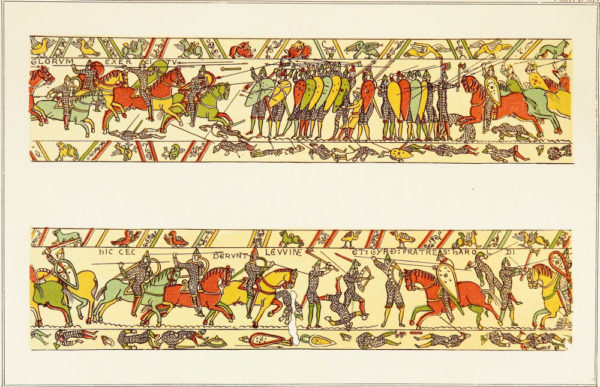
On our way to the town of Sainte-Mère-Église, we learned that Jacques was born, raised, and still lived in Caen. After twenty-five years teaching at the Sorbonne (a Paris university), Jacques began a second career as a licensed tour guide. He decided to specialize in the Normandy beaches and surrounding area. Jacques was five-years-old on 6 June 1944 when the Allied forces landed on five nearby beaches in the early morning. Caen was a strategic point for both the Allied armies and the Germans, and the townspeople knew it and left the city before the invasion ⏤ it’s fortunate they did as the town was completely destroyed except for the castle and two related churches.
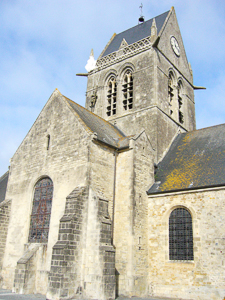
According to Jacques, his family went out into the fields, dug trenches and covered them with wooden planks and stayed there until the battle for Caen was over. At the age of five, it was hard for Jacques to stay put. Despite his mother’s attempts to keep him in the trenches, Jacques was able to get out and play in the fields. One day, there was an aerial dog fight overhead and bullets were hitting the ground. When bullets hit the ground, they splinter into multiple pieces. Shrapnel hit Jacques in the neck and the wound was so serious that immediate surgery was necessary. Jacques’ mother immediately began to search for a doctor. She couldn’t find a French doctor and the German doctors were under strict orders not to attend to any locals. She was fortunate to find a German doctor who disobeyed orders. Jacques will gladly show you the elongated scar on his neck where the doctor operated, removed the metal shard, and likely saved the little boy’s life.
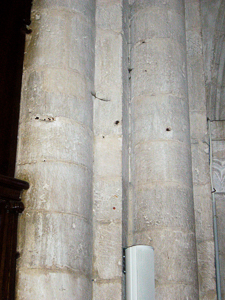
Licensed Tour Guide
In France as well as most of Europe, men and women attend university and obtain a degree and a license to become a tour guide. I guess it’s sort of like the “Good Housekeeping” seal of approval. We’ve had guides without the license and there is a noticeable difference. However, there is one aspect that sets Jacques apart and it is something that can’t be taught in school. This is why he has been the most sought-after guide for D-Day tours and called upon to escort visiting dignitaries.
When Jacques started as a guide, many of the men who survived D-Day came back to visit. He was fortunate to take hundreds of these men around. However, it really wasn’t Jacques who led the tours, it was the men. They showed Jacques where everything happened. They told Jacques first-hand stories of that day. He accumulated so much information over the years that he carries a large notebook with photos, maps, and notes. I tried to stump him with many of my questions, but he always had the answer. We were on Omaha Beach when I told Jacques about the famous scene in two movies about D-Day where a group of soldiers were ordered to connect sections of bangalore pipes and shove it into the side of a hill for the purpose of blasting a path for a breakaway off the beach. Jacque’s response was, “That story is true. Come, let me show you exactly where it took place that morning.” You see, one of Jacque’s tour clients was the former soldier who placed the final piece of pipe (there’s a scene depicting this in the movie, The Longest Day, with Robert Mitchum as the company’s leader, General Norman Cota). Watch a movie clip from The Longest Day here.
Two Shells At Ten In The Morning
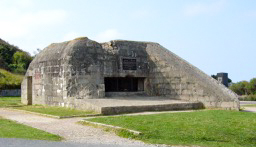
We’re walking down a road toward the beach from the parking lot above Omaha Beach when we stop at a bunker on the side of the road. The large gun is still in place. Jacques asks me if I knew what happened on the beach that morning. It kind of felt like this was either a trick question or he was sucking me into something. It turned out to be the latter.
I responded by saying that the men were held down on the beach until some of the ships came in dangerously close to the point of almost being beached. At that point, the ships’ artillery became more accurate. Jacques confirmed this and pointed to the bunker and said, “That is the gun that held the men on the beach and prevented them from advancing.” He went on to say that at ten in the morning, one of the ships fired two shots resulting in a direct hit on the bunker. I poked my head inside the bunker as far as I could. He pointed to two large holes in the back wall behind the gun. Jacques said, “Those were the two shots which knocked out this gun at exactly ten o’clock and the fighting came to a halt.” After four hours and countless casualties, the men were able to advance, and the beachhead was established. Watch the Coastal bombardment scene from The Longest Day here.
Saving Private Ryan
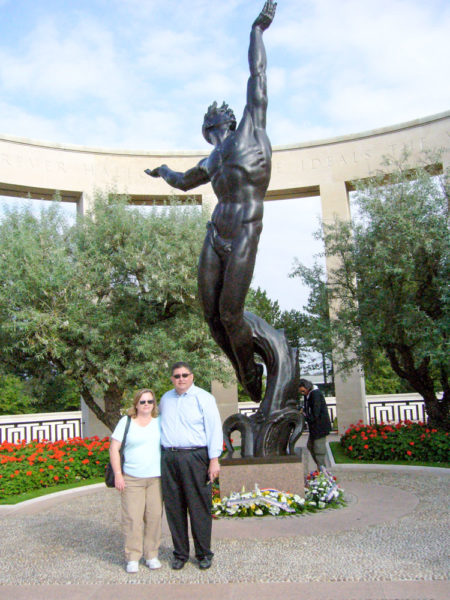
One of our stops was the Normandy American Cemetery and Memorial which overlooks the English Channel at Colleville-sur-Mer. After our visit to the Visitor’s Center, Jacques took us for a walk through the various plots, rows, and graves of some of the approximately 9,400 Americans buried in the cemetery. We stopped by a clump of trees in Plot C and Jacques told us he had been Steven Spielberg’s consultant for the movie’s beach scenes including the last scene where the older Ryan is standing over the grave of the fictional Captain Miller and asks his wife whether he was worthy of Miller’s sacrifice. We were standing on the spot where this scene was shot. Although it was the movie’s final scene, it was the first scene Spielberg shot. It was a Sunday around 5:00 PM and only an hour or so was required to complete the filming and according to Jacques, Spielberg had not come up with the name of Tom Hank’s character at that point. Jacques told us to turn around and there was a marble cross engraved with the name of John Miller. When Spielberg wrapped up filming that scene, he turned around and saw that cross. At that moment, Hanks’ character became Captain John Miller. Watch the final scene of Saving Private Ryan here.
Generations
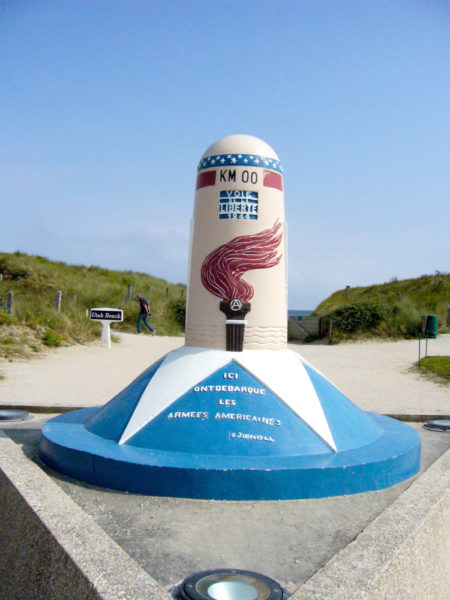
Jacques was able to elicit stories and facts from the men who survived not only D-Day but the days afterward which were just as dangerous as the initial four hours of the invasion. Most of us know that when the men and women came home from World War II, most of them never spoke of their experiences. How many times have you read about a former soldier dying and his children find his medals, clippings, and other war related artifacts hidden in a trunk up in the attic? Jacques told us that as the survivors died or were too incapacitated to return, their children replaced them as visitors and Jacques got to know them as well as he had their fathers. Only there was one big difference. The children didn’t know what role their fathers had played in the invasion. They never heard any of the stories that Jacques had accumulated. Years later, the grandchildren began showing up and became the third generation of visitors whom Jacques would take on tours of the beaches, marshes, and farmlands where their grandfathers had fought in mid-1944. This time, Jacques was amazed when the grandchildren could tell him all the stories. Watch a video of a D-Day vet visiting Normandy for the 75th anniversary here.
One Last Funny Jacques Story
About three years after we met Jacques, Sandy and I took our three children and their spouses to France for two weeks. We rented a house in Honfleur which was a reasonable drive to the Normandy beaches. We were really lucky to be able to book Jacques for a day and he took the six of them on “the D-Day tour.” We had dinner that evening at the house and one of our sons said, “Do you know what Jacques told us today?” I replied no but tell us anyway. Jason said that Jacques believed Americans were too impatient and did not spend enough time seeing all of the necessary sites. In other words, their one-day tour should have been three days.
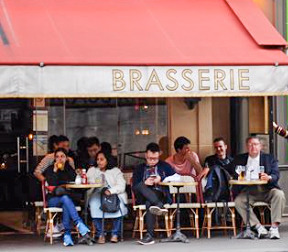
I told the kids we would be leaving shortly for two days and a night in Paris ⏤ just enough time for them to get a sample of Paris without me having to shell out the big bucks. I suggested they sit down at a bistro, order a glass of beer or wine, and watch how fast the Parisians walk. I told them they will see that the French and the Americans walk equally fast going from Point A to Point B. But here’s the difference. When the American gets to Point B, they want to get to Points C, D, and F as quickly as possible while the French stop at Point B, sit down, and have a glass of wine. So, I think Jacques is probably correct. Jacques Perreau is an exceptional guide and probably a once-in-a-lifetime experience for us. He is a founding member of our Travel Guide Hall of Fame (along with Vince in Scotland and Raphaëlle in Paris). These are only a few of the stories about our experience with Jacques which we took home with us. But I hope it provides an example of why we always try and ditch the groups for the more private tour. The incremental cost is well worth the incredible learning experience (and countless stories you can tell friends when you get home).
✭ ✭ ✭ Learn More About The Normandy Beaches and D-Day ✭ ✭ ✭
Ambrose, Stephen E. D-Day: June 6, 1944: The Climactic Battle of World War II. New York: Simon & Schuster, 2013.
Corman, Gene (Producer). The Big Red One. Lorimar Productions, 1980. Watch the movie trailer here.
Crosswell, D.K.R. Beetle: The Life of General Walter Bedell Smith. Lexington: The University Press of Kentucky, 2010.
Holland, James. Normandy ’44: D-Day and the Epic 77-Day Battle for France. New York: Atlantic Monthly Press, 2019.
Kershaw, Alex. The First Wave: The D-Day Warriors Who Led the Way to Victory in World War II. London: Dutton Caliber, 2019.
McManus, John C. The Dead and Those About to Die: D-Day: The Big Red One at Omaha Beach. London: Penguin Group, 2014.
Ryan, Cornelius. The Longest Day. New York: Simon & Schuster, 1959.
Spielberg, Steven (Producer). Saving Private Ryan. DreamWorks Pictures, 1998. Watch the movie trailer here.
Zanuck, Darryl F. (Producer). The Longest Day. Darryl F. Zanuck Productions, 1962. Watch the movie trailer here.
There are tons of books out there which deal with D-Day. I’ve listed what I consider to be the ones I’ve enjoyed reading along with the three movies which depict D-Day in a realistic manner. The best book for an inside look at the planning, politics, and strategies of D-Day is Mr. Crosswell’s book on General Bedell Smith, Ike’s right-hand officer.
What’s New With Sandy and Stew?
Sandy and I returned late last night from our trip to Egypt and we’re really tired. But I want you to know I will be writing about the highlights in our blog, Cleopatra in Paris, which will post on Saturday, December 7th.
Someone Is Commenting On Our Blogs
Thanks to Mark N. for reaching out to us with a question about Marie-Madeline Fourcade’s husband, Hubert (read Noah’s Ark, here). Mark wanted to know if General Louis Fourcade was Hubert’s brother. While there is very little written about either, including family histories, I was able to kind of back in to a conclusion. Hubert was born on 8 November 1909 in Marseille while Louis was born six days later on 14 November 1909 in the town of Tarbes. So, I made the assumption they were not brothers. Thanks Mark for visiting our web site and the blogs.
If there is a topic you’d like to see a blog written about, please don’t hesitate to contact me. I love hearing from you so keep those comments coming.
Why Would You Want To Buy Our “Walks Through History” Books?
Simple.
You like to travel and experience history and historical events. You like to see original buildings that had a significant impact on the people and events of the history you’re engaged with. You want to know the stories behind the brick and mortar in front of you.
The walking tour books are meticulously researched so you can go directly to those sites and learn about the building’s history as well as an introduction to some of the more interesting people associated with it.
We Need Your Help
Please tell your friends about our blog site and encourage them to visit and subscribe. Sandy and I are trying to increase our audience and we need your help through your friends and social media followers.
Thank You
Sandy and I appreciate you visiting with us. We have some exciting things on the horizon and we’ll keep you updated as we go along.
Share This:
Follow Stew:
Find Stew’s books on Amazon and iBooks.
Please note that we do not and will not take compensation from individuals or companies mentioned or promoted in the blogs.
 Walks Through History
Walks Through History
Copyright ©2019 Stew Ross

This summer we toured Utah beach (behind the scenes / paratrooper movements) with Allan Bryson, who also met many of the vets and all of the main character vets from Band of Brothers. We learned so much from standing on the ground and hearing what happened where. We got a new picture of Brecourt Manor guns, for example. That tour day was priceless. We also enjoyed an in-depth tour one day of the British / Canadian beaches. As you say, Americans tend to move too fast, and we wanted to tour all 5 D-Day beaches for a more comprehensive overview. We were the only Americans on the British beaches tour and we got teased, but we certainly learned a lot! I would recommend Americans take more days and tour ALL the beaches if possible!